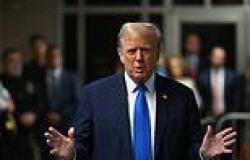On the face of it, America has little to fear from China's new deal to upgrade Cuba's power grid. The countries are already firm allies via their Communist leaders, Havana is under a diplomatic and economic embargo from Washington, and all efforts to mend ties between the two ended when Obama left office.
But scratch the surface and what emerges is a picture of Chinese economic dominance in America's backyard that would be enough give any president sleepless nights.
In fact, the deal with Cuba - signed this week as part of China's trillion-dollar Belt and Road Initiative - is just the latest in a long line of loans, trade deals, construction projects and other investments in Latin American and the Caribbean that has seen Beijing flex its growing economic muscle while America's strength wanes.
Since 2005, China's three largest state investment banks have loaned some $140billion to countries in Latin American to pay for everything from nuclear power stations to dams, roads to railways, ports and phone networks.
Billions more - nobody knows quite how many - have been lent via contracts with commercial banks, private finance initiatives and other deals which are opaque and hard to track, though researchers have found they sometimes dwarf deals done on-the-books.
Meanwhile Chinese trade with Latin America has shot up more than 25 times, rising from $12billion in 2000 to $315billion in 2020 as almost half of the countries in the region saw their largest trading partner flip from being the US to China - including three of the four largest economies, in Brazil, Argentina and Colombia.
All of which gives China leverage that it uses to get its own way on the international stage, from winning votes at the UN to isolating its enemies - most notably Taiwan, as Beijing often requires countries to cut diplomatic ties with the island before it will hand over money.

China's state banks have loaned some $140billion to Latin American and Caribbean countries since 2005, which is thought to be just a fraction of the money that has flowed to the region when private deals are taken into account. Beijing is also involved in major infrastructure and energy projects in most countries, including transport networks and power stations
For Thomas Shannon, former Under Secretary of State for Political Affairs from 2016 to 2018, Beijing's economic strategy is also a way of mirroring and neutralising American threats in its own back yard.
Speaking to Time magazine earlier this year, he said: 'For China, the United States has its navy in the South China Sea, a military ally in Taiwan and has been harassing [them] about Hong Kong. This way, China can show the United States that we can play in your neighborhood just how you play in ours.'
China's route to economic dominance in the region has followed a pattern that it has repeated in other parts of the world, most prominently Africa: Make available large amounts of low-interest money and cheap labour to help build key infrastructure, run up a large bill, then use that to exert control.
Paraguay, Venezuela and Ecuador all have debts with China of more than 10 per cent of their GDP, according to statistics agency Statista, making them vulnerable to any changes in the terms of those loans.
Several more Caribbean nations - among them Grenada and the Dominican Republic - are thought to be in similar position having taken tens of millions or billions in loans for projects, despite having small economies.
According to the China-Latin America Finance Database, the largest recipient has been Venezuela with some $62billion in loans, followed by Brazil, Ecuador, Argentina and Bolivia.
Cuba has been loaned just $240million, according to official records, but was the beneficiary of a debt restructuring that saw China write off around $6billion in loans in 2011 - by far the largest amount of debt that China has opted to forgive.
Still more countries have signed up to China's Belt and Road initiative, a global $1trillion construction project that aims to improve trade networks and infrastructure which will be beneficial to China in the long run.
Notable partners include Venezuela - which also has a large amount of debt to China - Ecuador and Panama, which contains the hugely valuable Panama Canal which was originally built using US funding.
Cuba is another country that has singed up to Belt and Road, and this week announced that it will accept Chinese help to upgrade its power network with a






